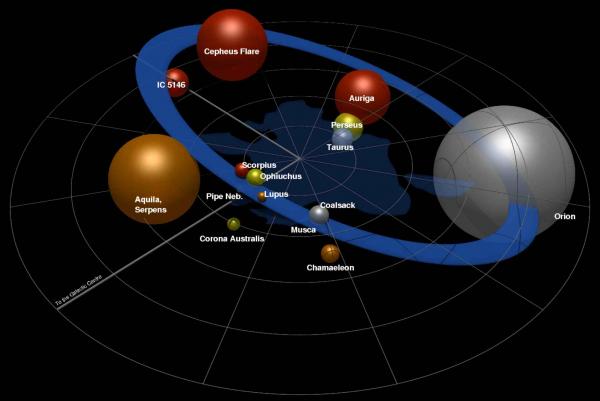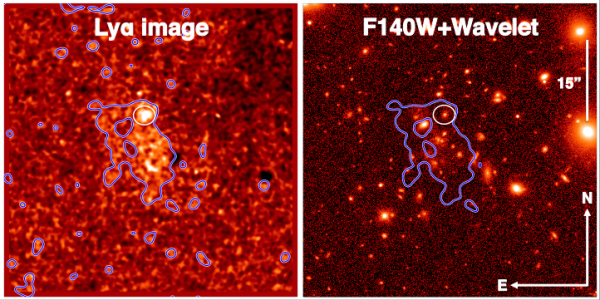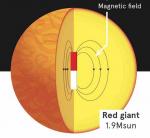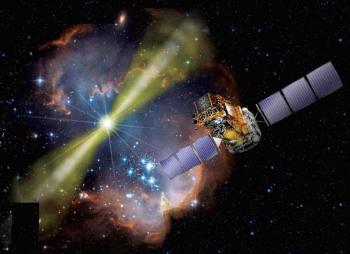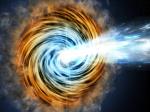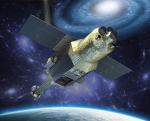News 2016
Based on observations of nearby molecular clouds with the Herschel space observatory, recently large samples of future stars were detected in the form of dense cores. The properties of these compact seeds and their connection with interstellar filaments reveal us the earliest key stages of stars and the way of low-mass star formation.
Among several cloud complexes along the Gould Belt (see image below) the Aquila and Taurus regions were targeted. While the star formation in Aquila was relatively unexplored until recently, the Taurus cloud with its main filaments is well known. The Aquila Rift lies above the Galactic plane at the distance of about 260 parsec (approximately 850 light-years from the Sun). The Taurus region is more nearby, it seems to sit in the wall of the Local Bubble - a cavity, surrounding the Solar System- at 140 parsec (or 450 light-years) from us.
An international team led by researchers from the “Service d'Astrophysique / Laboratoire AIM” of CEA-IRFU has discovered a giant nebula of ionized gas in the central region of the distant galaxy cluster CL J1449+0856. Extending over 300,000 light-years, this nebula was detected from an emission line of hydrogen, arising from a gigantic reservoir of warm gas probably ionized by two luminous quasars of the cluster. It is the first time that astronomers find in a distant galaxy cluster such a giant emission from warm gas coexisting with the hot intracluster plasma, detected with X-ray telescopes. The hot and warm gas are likely to interact, causing the evaporation of the nebula and setting its time evolution. This discovery suggests the existence of a physical connection between gas reservoirs and the first evolutionary stages of the largest bound structures of the Universe. This work is published by Francesco Valentino and his collaborators in the revue The Astrophysical Journal.
An international collaboration, involving the Astrophysics Department-AIM Laboratory of CEA-IRFU, managed to determine, from asteroseismology, that up to 65% of stars more massive than the Sun (between 1.6 and 2 solar masses) have a very high internal magnetic field. So far, only 5-10% of these stars were suspected to have a magnetic field up to 10 million times that of Earth. This unexpected discovery demonstrates the importance of a "dynamo effect" able of maintaining intense fields in the interior of stars. These results, obtained using the Kepler satellite data [1], are published in the journal Nature on 21 January 2016.
Using several thousand images of Saturn's moons produced by the Cassini probe (NASA/ESA), an international team led by an astronomer from the Observatoire de Paris in the Institute of Celestial Mechanics and Calculation of Ephemerides ( Observatoire de Paris / CNRS / UPMC / Université Lille 1), in collaboration with CEA researchers, has succeeded in bringing to light small fluctuations in the gravitational field of the planet. These extremely fine results are the outcome of a series of works carried out by the same team on the Saturn ecosystem and should allow to better understand the internal structure of Saturn. These results are in press in the International Journal Icarus and are the subject of an video.
For more information : see the French version
One instrument of the INTEGRAL satellite that continuously monitors the sky was active at the time of the discovery by the LIGO instrument of the first ever-detected gravitational wave, GW150914, resulting from the merger of two black holes. It allowed to search the existence of a high-energy source of light, associated with this exceptional event. With a detector covering almost the entire sky, INTEGRAL has concluded that, at the exact moment of the passage of gravitational waves in the Earth environment, no strong emission of gamma rays appeared. In theory, the merger of two holes is not accompanied by any light emission and this observation confirms this scenario. The capacity of the INTEGRAL satellite to detect brief and sudden events in the sky (as for its multiple detections of gamma-ray bursts) may prove very valuable to study other sources of gravitational waves such as the merger of neutrons stars or the explosions of very massive star, potential sources of both gravitational waves and gamma radiation. These results are published in the journal Astrophysical Journal Letters of March 30, 2016.
Analysis of the high-energy emission from the microquasar V404 Cygni has lead to the discovery of gusts of electron and positron (the electron anti-particle) plasma. This amazing discovery was possible thanks to the exquisite sensitivity of the INTEGRAL/SPI spectrometer during a strong outburst of the source in June 2015. These findings show that microquasars can be very efficient to provide significant pairs electron-positron and thus can be considered somehow as “antimatter factories”. V404 Cygni shows during this outburst several types of flares, detected at all wavelengths, some of them reaching records of brightness in the gamma-ray range. This diversity is described in a complementary study, which shows that in this binary system, high velocity matter ejections occur in form of jets. These observations highlight the key role of microquasars in the origin of the diffuse emission of electron-positron annihilation line in the galactic bulge and the still poorly known galactic gamma-ray background diffuse emission. These studies are described in two papers, the first under the leadership of a team from the Max-Planck-Institut für extraterrestrische Physik (MPE) in Garching, Germany and published in the 2016 February 29th edition of Nature, and the second lead by researchers from the Astrophysics division/laboratory AIM of CEA-Irfu and published in the revue Astronomy and Astrophysics end of 2015. In both studies, scientists from MPE and SAp joined their effort with other colleagues to analyse data from the INTEGRAL satellite, currently the unique high energy observatory allowing such findings and discoveries.
The X-ray astronomy satellite Astro-H was successfully launched on 17 February 2016 at 17H 45 (UT 8H45) from the JAXA Tanegashima Space Center in Japan. The satellite was put into orbit 14 min later and the first tests started. ASTRO-H is a JAXA / NASA mission under the Japanese leadership and with an ESA participation. This new observatory aims to observe and study the hot and energetic Universe. Astro-H embeds several instruments that when combined cover the spectral band 0.3-600 keV. Among the instruments on board, the spectrometer SXS is equipped with a state-of-the-art X-ray calorimeter. This detector, cooled to a temperature close to absolute zero, will achieve unmatched performances in terms of spectral resolution. CEA is involved in the mission, technically and scientifically, through the ESA contribution and support from the French space agency CNES.
After this sucessful launch, JAXA decided to rename Astro-H "Hitomi".
Observations of Malin 1, a nearby galaxy and a perfect prototype of the "giant galaxies with low surface brightness," have allowed scientists from an international team including a researcher from the Astrophysics Laboratory-Service AIM CEA-IRFU to make an unexpected discovery that challenges the assumptions about galaxy formation process of this type. It suggests that the giant disk in Malin-1, the largest known in the universe, is not the consequence of a collision but is in place for several billion years, and that stars are formed there in a modest but steady rate over the long-term. Because of their diffuse appearance and their very low gloss, these massive galaxies are difficult to observe and remain unknown today. They could be a significant fraction of the galaxies in the universe, as similar objects as Malin 1 may have escaped our vigilance.
The paper, published in Astronomy and Astrophysics, presents for the first time images of Malin 1 obtained six different wavelengths - from ultraviolet through GUViCS1 project in optical and near infrared through NGVS1 project with the camera MegaCam Canada France Hawaii Telescope, CFHT developed at the CEA [1]. Originally planned to study the Virgo cluster, these large observation campaigns also allow working on other objects in the background of this cluster, as is the case in this study.
For more information : see the French version
